![]()
![]()
![]()
Use LEFT and RIGHT arrow keys to navigate between flashcards;
Use UP and DOWN arrow keys to flip the card;
H to show hint;
A reads text to speech;
158 Cards in this Set
- Front
- Back
|
two views you must obtain in radiography |
orthogaonal and AP/Lateral |
|
|
stress view is important in evaluating this in radiography - |
ligamentous tears joint stability |
|
|
ultrasound is used to evaluate - |
soft tissue, ligaments, tendons, muscle, and nerves |
|
|
CT is used to evaluate - |
complex fractures of the spine, pelvis and scapula |
|
|
one advantage of CT over conventional radiography is that - |
excellent contrast and 3D reconstruction |
|
|
bone scintigraphy involves - |
injection of radioactive material into vein and it travels through blood to bone/organs. gives radiation detected by camera. |
|
|
bone scintigraphy is useful in detecting - |
occult fractures or those that are too subtle to be seen on normal xray |
|
|
bone scintigraphy is helpful in distinguishing - |
non-infected and infected fractures bone cancer |
|
|
angiography |
radio-opaque agent into blood vessel and image with x-ray |
|
|
angiography is used to evaluate |
arteries ad veins |
|
|
MRI used for |
spinal imaging, ligament assessment, tendon, muscle, bone, soft tissue tumors |
|
|
MRI is used more preferentially then --- because it -- |
CT no ionizing radiation. |
|
|
classes of bone - |
long short flat sesamoid irregular |
|
|
examples of each class of bone - |
long - femur short - carpals flat - sternum sesamoid - patella irregular - vertebrae |
|
|
long bone fractures are described by referring to - |
the direction of the fracture line in relation to the shaft of the bone. |
|

|
long bone fracture transverse fracture
|
|
|
transverse fracture is described as - |
perpendicular fracture across the bone shaft |
|

|
oblique long bone fracture |
|
|
oblique long bone fractures are - |
fractures passing at an angle oblique to the shaft of the long bone. |
|

|
spiral long bone fracture |
|
|
spiral long bone fracture is - |
from a twisting injury line spirals along shaft of the long bone. |
|

|
sagittal plane fracture of the tibia |
|
|
sagittal plane fractures of long bones are described as - |
fracture passing along the shaft of a long bone. described in reference to the plane in which it passes. |
|
|
fractures of irregular bones require - |
description determined by direction through the bone |
|
|
in irregular bone fractures, this is commonly seen - |
fracture seen passing through many directions. |
|

|
coronal and axial fracture of irregular bone |
|
|
comminuted fracture |
fracture resulting in more than two separate bone components |
|

|
comminuted fracture |
|
|
butterfly comminuted fracture |
two oblique fractures forming what looks like a butterfly fragment |
|
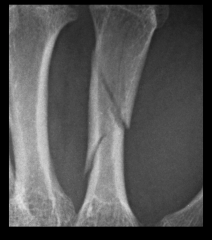
|
comminuted butterfly fracture |
|
|
segmental comminuted fracture |
segments of bone have separated from both proximal and distal portions of shaft |
|

|
segmental comminuted fracture note: prox and distal portions of fibular and tibial shaft |
|
|
fracture displacement is defined in terms of - |
defined in terms of the abnormal portion of distal fracture fragment in relation to the proximal bone |
|
|
fracture displacement is defined AS - |
loss of alignment or displacement accompanied by some degree of angulation, rotation or altered bone length |
|

|
fracture displacement- combined. -oblique fracture of the humerus -midshaft -lateral displacement -shortening -valgus angulation -internal rotation |
|
|
shortening with a fracture occurs when - |
proximal migration of the displaced bone occurs (displaces to the side and up) |
|
|
this fracture is more readily shortened - |
oblique as compared to transverse |
|
|
can a fracture be displaced without shortening? |
YES |
|
|
angulation of a fracture - |
break and then moves left or right but stays in the same general place e- |
|
|
medial angulation can be termed - |
varus |
|
|
lateral angulation can be termed - |
valgus |
|
|
fracture rotation occurs - |
when one part of the bone rotates compared to the other - heart to pick up without landmarks |
|
|
fracture distraction occurs - |
increased overall bone length due to widening of space between bone parts |
|
|
fracture impaction occurs - |
when shortening of bone without loss of alignment - components driven into each other. |
|
|
most bones develop from - |
cartilaginous ossification centers |
|
|
diaphysis |
shaft |
|
|
epiphysis |
end |
|
|
during growth ----- separates the diaphysis and epiphysis |
epiphyseal plate |
|
|
metaphysis |
zone adjacent to the growth plate on the diaphyseal side |
|
|
sesamoid bone |
bone that ossifies within a tendon.
|
|
|
largest sesamoid bone |
patella |
|
|
sesamoid bones are common here - |
metatarsophalangeal joint (big toe) metacarpophalangeal joint (thumb) |
|
|
apophysis |
normal developmental outgrowth of a bone which arises from a separate ossification center. |
|
|
apophysis usually does not - |
form direct articulation with another bone at the joint |
|
|
apophysis will often form - |
insertion point for tendon or ligament |
|
|
apophysis is most common in - |
children |
|
|
bone is made of - |
outer cortex and inner medulla |
|
|
cortex is - |
denser and whiter |
|
|
medulla is - |
less dense and darker/radiolucent |
|
|
most joints are considered - |
synovial |
|
|
most joints are composed of - |
articulating bones lined with hyaline cartilage and contained by synovial capsule |
|
|
approach to looking at x-rays |
patient and image data bone and joint aligment joint spacing cortical outline bone texture soft tissues |
|
|
when looking at images, the first thing you want to do is to |
check to make sure you are looking at the correct images. |
|
|
loss of bone alignment can be due to - |
bone fracture joint dislocation |
|

|
loss of bone alignment at middle toe metatarsophalangeal joint due to dislocation |
|
|
joint space may be narrowed due to |
cartilage loss |
|
|
joint space may be widened due to |
dislocation or dissociation |
|

|
longstanding foot pain osteoarthritis of 1st MTP joint large osteophytes sign of osteoarthritis |
|
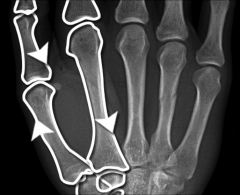
|
fractured ring finger boxer's fracture |
|
|
trabeculae |
fine matrix of white lines |
|
|
distortion of trabecular pattern may indicate |
abnormality! |
|
|
joint effusion |
contains fat and blood that has leaked from bone following trauma |
|
|
lipohaemarthrosis |
fat and blood |
|

|
tibial plateau fracture note fat and blood |
|

|
twisting injury unable to bear weight lat malleolus tender olbique fracture of distal fibula and level of ankle joint
|
|

|
irregular outline of cortical right femoral head groin pain post fall shortened, ext rotated right leg. fractured neck of right femur |
|
|
fractures of proximal femur are common in - |
eldery osteoporotic patients |
|
|
if a fracture is not displaced, these might not show - |
shortened and externally rotated leg. |
|
|
shenton's line |
formed by medial edge of femoral neck and inferior edge of superior pubic rams |
|
|
loss of contour of shenton's line indicates - |
fracture neck of femur |
|
|
fractures of femoral neck do not always cause - |
loss of Shenton's line |
|
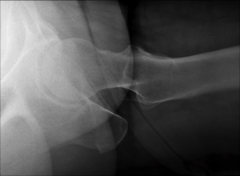
|

|
|
|
proximal femoral fractures either involve - |
bone enveloped in ligamentous hip joint capsule or bone below the capsule |
|
|
intracapsular vs. extracapsular |
proximal femoral fracture intra - enveloped by joint capsule extra - below capsule |
|
|
intracapsular fractures |
subcapital transcervical basicervical |
|
|
extracapsular fractures |
intertrochanteric subtrochanteric NO INVOLVEMENT OF FEMORAL NECK! |
|
|
subcapital intracapsular fracture |
disrupted shenton's line. increased femoral neck density - overlapping impacted bone. prominent lesser trochanter |
|

|
subcapital intracapsular fracture |
|
|
garden classification system |
assesses severity of femoral neck fractures. more displaced, more likely blood supply is compromised. |
|

|
garden IV complete fracture
no shentons total displacement.ext |
|
|
extracapsular fractures do not involve |
femoral neck |
|

|
extracapsular fracture intertrochanteric |
|
|
intertrochanteric fracture |
runs between trochanters comminutin and separation of lesser trochanter NO FEMORAL NECK |
|

|
subtrochanteric fracture |
|
|
subtrochanterc fracture |
distal to trochanters femoral neck in tact. |
|
|
femoral shaft fractures are typically from - |
high force impact |
|
|
femoral shaft fractures result in - |
highly displaced fractures that are easily recognized. |
|
|
fracture of femoral shaft without history of high force trauma, think - |
pathology |
|

|
femoral shaft fracture |
|
|
knee fractures viewed in the --- view because it ----- |
AP view allows for effusions to be visualized in supra patellar pouch |
|

|

|
|
|
this view is useful for visualizing knee fractures |
horizontal beam lateral view |
|
|
knee joint effusion is indicated by - |
widening of fat pads or increased density in the area. |
|
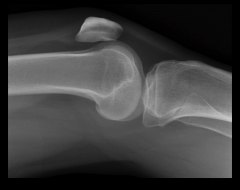
|

|
|
|
sunrise view |
patella view |
|
|
sunrise view is only necessary if - |
standard views are normal but patellar fracture is still suspected. |
|
|
sunrise view can only be done if - |
knee flexion can be tolerated. |
|
|
tibial plateau fractures |
subtle. varying degrees of displacement or comminution |
|
|
formation of ---- is the only radiological sign of a tibial plateau fracture |
lipohaemarthrosis |
|
|
lipohaemarthrosis |
layered effusion of fat and blood which has leaked from bone following a fracture. |
|

|
tibial plateau fracture |
|

|

|
|
|
view patellar fractures most often seen on - |
lateral view |
|

|

|
|
|
fabell |
normal sesamoid bone of lateral head of gastrocnemius tendon. not mistaken for fracture or loose body. |
|

|
fabella of knee |
|
|
bipartite patella |
patella in two parts. injury to the interface is possible. |
|

|
bipartite patella |
|
|
tibia and fibula fractures require - |
high force impact |
|
|
stress fractures can occasionally cause - |
chronic tibial pain |
|
|
stress injuries due to - |
repeat low force trauma to normal bone. |
|

|
comminuted fracture of tibial and fibular shafts with medial displacement and posterior angulation |
|
|
tibial stress fracture |
periosteal stress reaction - signs of stress injury. |
|

|
periosteal stress fracture |
|
|
Toddlers Fracture |
spiral tibial fracture in young children associated with twisting injury. refusal to bear weight little/no displacement subtle fracture line. |
|

|

toddlers fracture
|
|
|
ankle x-ray is only needed if - |
pain in alleolar zone + bone tenderness in A -or- B -or- can't bear weight ASAP and in ED |
|
|
foot x-ray series only needed if - |
pain in midfoot + tender in C -or- D -or- can't bear weight |
|
|
mortise view |
AP ankle view. not true view because it is a bit oblique |
|
|
three bones of the ankle joint |
tibia fibula talus |
|
|
ankle fractures usually involve the - |
distal tibia distal fibula |
|

|

|
|
|
weight bearing portion of ankle formed by - |
tibial plafond talar dome |
|

|
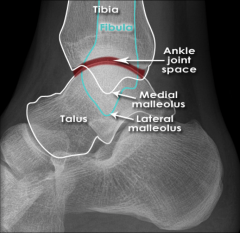
|
|
|
weber fracture |
classification for ankle fracture. |
|
|
Weber Classification: A B C |
A = distal to ankle joint B = at level of ankle joint C = proximal to ankle joint |
|
|
bimalleolar fracture |
transverse medial malleolus fracture. lateral malleolus fracture at level of ankle joint. joint widened medially due to lateral displacement. |
|

|

bimalleolar fracture |
|
|
trimalleolar fracture |
medial malleolus lateral malleolus posterior malleolus
unstable joint and widened anteriorly talus displaced posteriorly and laterally along medial and lateral malleolus bone fragments |
|

|

trimalleolar fracture |
|
|
maisonneuve fracture |
proximal fibula associated with injury to medial side of the ankle. disrupts tibiofibular syndesmosis. |
|
|
key components of maisonneuve fracture |
- disruption of medial ankle joint - disruption of distal tibia-fibular syndesmosis - no fibular fracture - talus translation |
|
|
maisonneuve fracture proximal tibia-fibula |
spiral fracture of proximal fibula |
|
|
osteochondral fracture |
fracture of talus bone surface subtle. assess carefully.
|
|
|
calcaneal fractures due to - |
falling from a height. they are hard bones to fracture Bo |
|
|
calcaneal fractures are often - |
comminuted and intra-articular |
|
|
Bohler's Angle |
severe injury may result in flattening of calcaneus which decreases this angle.
formed by the intersection of two lines - upper edge of calcanea bone posteriorly to upper edge of posterior articular facet of the calcaneus at the subtler joint then draw to upper edge of anterior process of calcaneus. |
|
|
Bowler's Angle is normally - |
28-40 degrees. |
|
|
hindfoot is composed of - |
calcaneus and talus |
|
|
midfoot is composed of - |
navicular + cuboid + cuneiform |
|
|
forefoot is composed of - |
metatarsals +phalanges |
|
|
big toe = |
toe 1 |
|
|
lisfranc injury |
lisfranc ligament - stabilizes mid-forefoot junction. loss of alignment of 2nd metatarsal base with intermediate uniform indicates injury to this important ligament
2nd metatarsal displaced from intermediate cuneiform |
|
|
phalanx fracture |
heal quickly w/o much mobilization buddy taping 2-3 weeks off of running |
|
|
metatarsal shaft fracture |
oblique fracture of 5th metatarsal shaft |
|
|
5th metatarsal base fracture |
three types: - styloid [heals well] - metaphyseal-diaphyseal junction - proximal diaphysis |
|
|
jones fracture |
metaphyseal - diaphyseal junction does not heal well. non-union -avascular zone |
|
|
meta-tarsal stress fracture |
common in athletes. fusiform bone expansion suble periosteal stress reaction of metatarsal. |

